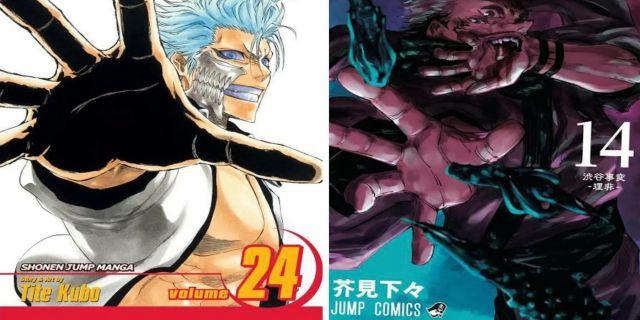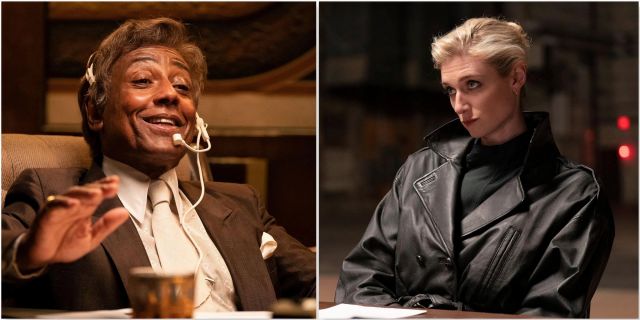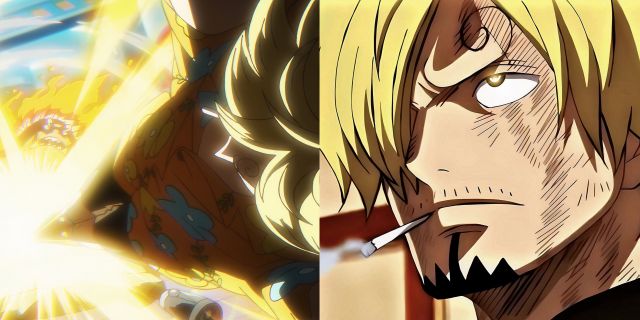Highlights
- JUJUTSU KAISEN and BLEACH share similarities in their portrayal of souls and spiritual realms, with Cursed Spirits and Hollows both feeding on human beings and evolving into more powerful forms.
- Both series explore the concept of vessels of supernatural power, with characters like Tengen and the Soul King being immortal beings that are fused with individuals known as vessels.
- JUJUTSU KAISEN and BLEACH delve into the idea of hybrid existences, with the evolution of Curses and the creation of Arrancars showcasing the blending of different beings and powers within the same vessel.
The following contains heavy spoilers for JUJUTSU KAISEN, for BLEACH: Thousand-Year Blood War, as well as for the BLEACH: Can’t Fear Your Own World novel trilogy by Ryohgo Narita, all available on VIZ’s online manga platform.
There are many comparisons made between the stories of Gege Akutami’s JUJUTSU KAISEN and Tite Kubo’s BLEACH. With MAPPA’s adaptation of JUJUTSU KAISEN, countless homages to shōnen titles have been made through animation and direction. That being said, as one catches up to the JUJUTSU KAISEN manga, a few deeper similarities between this world and that of BLEACH arise.
Someone with a solid foundation in the lore of both titles, and just a little bit of sense and imagination, could make the claim that the world created by Gege Akutami is comparable to a version of the BLEACH universe where the total separation of the realms never happened in the first place. How could that be the case?
RELATED: Jujutsu Kaisen: Nobara’s Name Pun, Explained
Both Series Deal With Souls, But In Very Different Ways

In BLEACH, the structure of the universe is based on the journey of the soul. The universe was split into three parts for the sake of creating order through separating the processes of life and death that made up the primordial chaos. The World of the Living, where souls would incarnate and lead human lives, would be the first destination of souls coming from the afterlife, or “Soul Society”. When people died and passed on peacefully, they would be sent to Soul Society by the Shinigami, where their soul would once again be sent to the World of the Living; however, evil spirits known as Hollows would manifest from the souls that couldn’t pass over peacefully, a process that is known as “Hollowfication”. These evil spirits reside in Hueco Mundo, a purgatory or limbo realm that exists in the interstice between Soul Society and the World of the Living. Hollows would then feed on the souls of the living and the dead, in turn creating more Hollows, which are effectively the result of a soul lost to despair.
This concept is quite similar to JUJUTSU KAISEN‘s presentation of Cursed Spirits, which are malignant spirits borne from the negative emotions and beliefs of human beings, which then feed on human beings, sometimes to the point of evolving into an even more powerful, negative force. Unlike in BLEACH, death to this malignant spirit does not then turn one into a Curse; however, when a Jujutsu Sorcerer – a person with the ability to manipulate Cursed Energy and perform sorcery – is killed through means other than by Jujutsu, they rematerialize as Cursed Spirits, a process that is eerily similar to Hollowfication. The significance of such a process is that it deepens the connection between humanity and Curses. Souls exist in JUJUTSU KAISEN, and complete destruction of a soul is a dire final possibility, but the importance of this element is that it explains how a person’s ego can survive their reincarnation into a Vengeful Cursed Spirit.
Both Series Explore Vessels of Supernatural Power

JUJUTSU KAISEN is set almost completely in modern-day Tokyo (between 2017 and 2018), and the connection to a higher realm of some kind exists through an entity known as “Master Tengen”, an immortal Jujutsu Sorcerer responsible for spreading and preaching the foundations of Jujutsu sorcery, and worshiped as a deity known as the “Star”. Every 500 years, Tengen is supposed to fuse with an individual known as a “Star Plasma Vessel”, maintaining their immortality and enabling them to hold on to their humanity. However, in 2006, Tōji Fushiguro murdered the Star Plasma Vessel Riko Amanai, and the failure to assimilate caused Tengen to become more of a Cursed Spirit than a human, as the entity “evolved” past their humanity and “became the world itself”. Tengen’s body is housed in the Tokyo Jujutsu Technical High, in the Tomb of the Star, a region deep within the campus that is hidden behind barriers and 1000 doors that shuffle constantly, making admission to the sacred space nearly impossible.
Tengen’s status in the Jujutsu world is reminiscent of the role of BLEACH‘s Soul King, who is the cornerstone that makes the tripartite separation of the realms possible. Like Tengen, the Soul King is effectively entrapped, although the conditions are vastly different, as Tengen is still capable of agency. The Star Plasma Vessels are reminiscent of the fragments of the Soul King, revealed during the Thousand-Year Blood War arc. The Soul King’s various body parts represent concepts that affect reality itself in various ways, and he is murdered and mutilated in order to be made into the basis of the three realms. Parts of his mutilated corpse wind up being caught in the souls of the unborn, whose pregnant mothers were attacked by Hollows seeking the high concentration of spiritual energy found in the unborn.
Both Series Explore Hybrid Expressions of Basic Concepts

As early as 25 chapters into BLEACH was the first reference made to the Arrancar, introducing the possibility of hybrid existences. In BLEACH canon, it is generally accepted that Hollows seek out powerful souls to devour, and certain Hollows evolve beyond the basic limitations of their kind into various classes, the most notorious and powerful of which is the Vasto Lorde. As Hollows gain intelligence, their forms become more humanoid. Arrancars are Hollows that have broken their masks and gained Shinigami powers – placing these existences that are naturally at odds within the same vessel. In similar fashion, JUJUTSU KAISEN very early on presents a progression into more human-like forms as a part of the evolution of Curses.
The Soul King in BLEACH is a hybrid existence, one of the first beings and a combination of all the possible races in the BLEACH universe – Tengen’s evolution into more of a Curse after the failed assimilation with Riko Amanai reflects this “compositeness” of the cornerstone being, not to mention that the births of characters like Yuji Itadori and Chōso reflect the hybridization seen in the creation of BLEACH protagonist Ichigo Kurosaki, particularly in how his composition is a combination of unusual parentage as well as decisions in life leading to their harbouring of a malignant entity within their bodies. The biggest takeaways here are the similarities between the concept of Tengen and vessels to that of the Soul King and Fullbringers, but also the basic concept of hybrid existence being at the core of the -verse.
Souls Don’t Move On In JUJUTSU KAISEN

The biggest sign that there isn’t much of an afterlife in JUJUTSU KAISEN is the persistence of the soul in the body after death, as seen with Getō struggling against Kenjaku within his own body, and the brief return of Tōji Fushiguro. Sorcerers like Sukuna have tapped into some kind of immortality through turning themselves into Cursed Objects, meaning that they can return even if they are killed. The transformation of Zen’in Naoya into a Cursed Spirit shortly after his death indicates that there is no Hell, and even when the body of a living individual is possessed, the soul persists therein, making it unlikely that an afterlife exists in the JUJUTSU KAISEN universe. Conversely, Masamichi Yaga is actually capable of creating fully-functional Cursed corpses that can maintain their own cursed energy. This is reminiscent of the BLEACH modified soul and Gigai (Faux Body) concepts, and his ability specifically further expands the idea that souls and bodies are more closely related than usually depicted in fiction.
Both Series Explore Supernatural Societies

One of the most significant impacts of the Shibuya Incident Arc is how it explores more of Jujutsu Society. Gojō’s existence was keeping in check several key players from making any significant moves. However, in his absence, the balance shifted once more as Kenjaku brings back powerful sorcerers from 1000 years ago. The plotting, scheming and manipulation of Getō’s body is reminiscent of Aizen’s faked death and manipulation of the machinations of Soul Society through the murder of the Central 46, but Noritoshi Kamō’s experiments and creations of human-Curse hybrids is reminiscent of Aizen’s Hollowfication experiments with some kind of draw from the Hōgyoku’s impact on the BLEACH universe through the attraction of malice seen in Sukuna’s fingers, which are also sentient objects that have immense plot-altering potential.
Through the use of Getō’s body in particular, Kenjaku is able to implicate Gojō in the various events, also manipulating powerful members of Jujutsu Society to get rid of Yaga – much like Aizen’s plan sowed infighting among Gotei 13 Captains and would’ve made the innocent Rukia collateral damage in the grand scheme. The disgracing of the Kamō clan due to Noritoshi’s actions, as well as Maki’s decimation of the Zen’in Clan resembles the diminishing and eventual collapse of the Shiba Clan. Kenjaku’s simple curiosity in this chaos is more up the alley of Can’t Fear Your Own World antagonist Tokinada Tsunayashiro, head of the Great Noble Clan in BLEACH that maintains the recorded history of the Seireitei, and a family of immense influence over the entirety of the narrative from as far back as the primordial murder of the Soul King.
With multiple situations illustrating that souls in JUJUTSU KAISEN reside within the body after death, the idea of an afterlife in the same way it is seen in BLEACH falls away. Cursed Spirits as derivations of human negative emotion reside on the same plane as living people, so “evil spirits” in the JUJUTSU KAISEN universe don’t come from Hell or some other place; nor do the souls of the dead materialize in normal circumstances. Quincies are the closest thing to Jujutsu Sorcerers, particularly with the possibility of Soul damage presented by some individuals. In the primordial BLEACH universe, all the kinds of existences would incarnate all together, sometimes in various, incompatible mixes, making existence chaotic as life and death would persist without separation.
The JUJUTSU KAISEN universe is like a universe of such chaos, because humanity and Curses are mirror existences of such proximity, but also because those who are dead do not experience the kind of experience that leads to “resting in peace” as is generally understood, which is another indication of the same kind of primordial chaos seen before the Soul King’s sacrifice. In a universe where Heaven or Hell do not exist, powerful Sorcerers or entities simply rematerialize as Curses and seek out the living, while BLEACH’s Hell works as a plane where those who were incredibly powerful rematerialize as malignant entities of an unknown composition. Tengen’s assimilation with the world itself is also another indication of a chaotic universe where the natural and the supernatural are always one and the same.











Leave a Reply